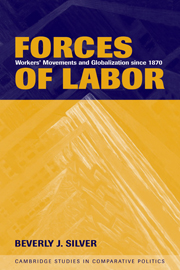Book contents
- Frontmatter
- Contents
- List of Figures
- List of Tables
- Preface and Acknowledgments
- 1 INTRODUCTION
- 2 LABOR MOVEMENTS AND CAPITAL MOBILITY
- 3 LABOR MOVEMENTS AND PRODUCT CYCLES
- 4 LABOR MOVEMENTS AND WORLD POLITICS
- 5 CONTEMPORARY DYNAMICS IN WORLD-HISTORICAL PERSPECTIVE
- Appendix A The World Labor Group Database: Conceptualization, Measurement, and Data Collection Procedures
- Appendix B Instructions for Recording Data from Indexes
- Appendix C Country Classifications
- References
- Index
- Cambridge Studies in Comparative Politics
2 - LABOR MOVEMENTS AND CAPITAL MOBILITY
Published online by Cambridge University Press: 05 June 2012
- Frontmatter
- Contents
- List of Figures
- List of Tables
- Preface and Acknowledgments
- 1 INTRODUCTION
- 2 LABOR MOVEMENTS AND CAPITAL MOBILITY
- 3 LABOR MOVEMENTS AND PRODUCT CYCLES
- 4 LABOR MOVEMENTS AND WORLD POLITICS
- 5 CONTEMPORARY DYNAMICS IN WORLD-HISTORICAL PERSPECTIVE
- Appendix A The World Labor Group Database: Conceptualization, Measurement, and Data Collection Procedures
- Appendix B Instructions for Recording Data from Indexes
- Appendix C Country Classifications
- References
- Index
- Cambridge Studies in Comparative Politics
Summary
This chapter analyzes the world-scale dynamics of labor unrest in what is widely regarded as the leading industry of twentieth-century capitalism – the world automobile industry. The first section of the chapter presents a picture of the temporal and spatial patterning of labor unrest in the world automobile industry from 1930 to the present based on indexes derived from the World Labor Group database. We identify a series of spatial shifts in the distribution of labor unrest – with the epicenter of militancy moving from North America through Western Europe to a group of newly industrializing countries over the course of the twentieth century.
The second section then narrates the dynamics of these spatial shifts and their interrelationship with successive rounds of capital relocation. We argue that mass production in the automobile industry has tended to recreate similar social contradictions wherever it has grown, and, as a result, strong and effective labor movements have emerged in virtually every site where Fordist mass production expanded rapidly. Yet each time a strong labor movement emerged, capitalists relocated production to sites with cheaper and presumably more docile labor, weakening labor movements in the sites of disinvestment but strengthening labor in the new sites of expansion.
Our story of the interrelationship between labor movements and capital relocation thus paints a far more ambiguous picture than that suggested by the race-to-the-bottom thesis (see Chapter 1). To put it in a sentence, the trajectory for the world automobile industry suggests that where capital goes, conflict goes. Or to paraphrase David Harvey (1989: 196; 1999: 390, 442), the geographical relocation of production is a “spatial fix” that only “reschedules crises” it does not permanently resolve them.
- Type
- Chapter
- Information
- Forces of LaborWorkers' Movements and Globalization Since 1870, pp. 41 - 74Publisher: Cambridge University PressPrint publication year: 2003
- 1
- Cited by

